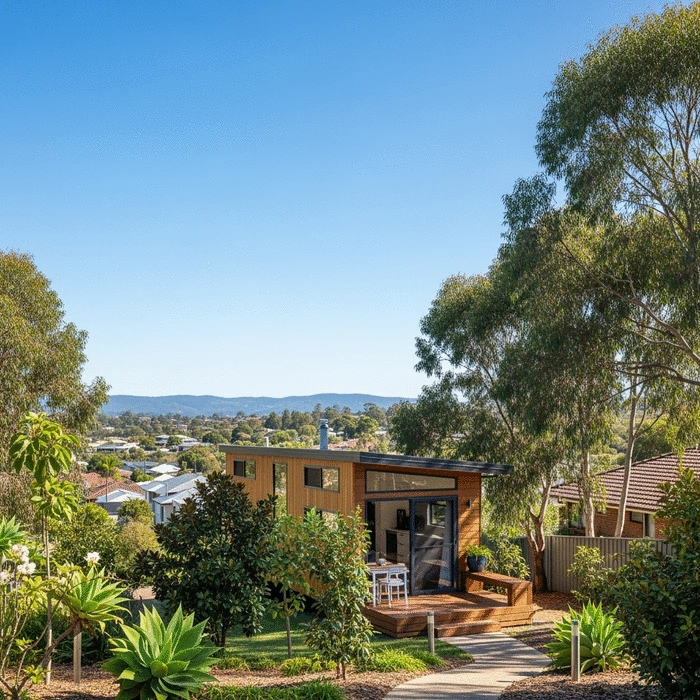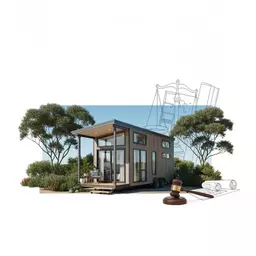Obtaining Tiny House Permits

Posted on: 2025-10-26
By: Sophie Marchant
As the tiny house movement continues to gain momentum, understanding the intricate web of permit requirements is crucial for aspiring tiny homeowners. The journey toward sustainable living begins with navigating local regulations to ensure compliance and safety in your new home.
What You Will Learn
- Legal Compliance is Key: Securing the right permits is essential to adhere to local building codes and safety standards.
- Consequences of Non-Compliance: Failing to obtain permits can lead to fines, demolition orders, and issues with insurance coverage.
- Engage Early with Local Councils: Building relationships with council representatives can provide insights and ease the permitting process.
- Understand the Development Application (DA) Process: A formal request is necessary for significant developments, including tiny homes, and may require public notification.
- Different Regulations for Foundations vs. Wheels: Tiny homes on foundations and those on wheels have distinct regulatory requirements that must be understood.
- Key Components of a Development Application: Include thorough site plans, design sketches, and impact statements in your DA for a better chance of approval.
- Stay Informed on Local Council Regulations: Each council has unique rules that can affect your tiny home plans, so ongoing research is essential.
- Utilize Resources for Ongoing Support: Local council websites, community groups, and workshops are valuable resources for staying updated and connected.
Key Steps in Obtaining Tiny House Permits
Understanding the essential steps can streamline the process of obtaining tiny house permits in Australian suburbs. For more insights on making informed decisions, consider choosing your ideal tiny home to align with permit requirements.
1. Research Local Council Regulations
Familiarize yourself with your local council's specific requirements for tiny homes.
2. Develop a Comprehensive Development Application
Ensure your application includes all necessary documentation for timely approval.
3. Engage with Council Representatives
Building a good relationship with local council can ease the application process.
4. Be Patient and Persistent
The permit process can take time. Prepare for potential delays and stay engaged.
Understanding Tiny House Permit Requirements in Australian Suburbs
When considering the exciting journey into tiny home living, understanding the permit requirements is essential. Each suburb in Australia has specific regulations that can impact your plans. As the founder of The Tiny Living Guide, I’ve seen many aspiring tiny home owners navigate the complexities of these requirements, and I want to help you make sense of it all!
Permits are not just official paperwork; they ensure that your tiny home meets legal compliance and safety standards. This means that your living space is safe, secure, and built to last. Keep in mind that having the right permits can also protect you from potential legal issues down the road.
The Importance of Permits for Tiny Homes in Australia
Why are permits so crucial for tiny homes? They serve several vital purposes:
- Legal Compliance: Ensures adherence to local building codes and safety regulations.
- Safety Standards: Protects the health and safety of you and your neighbors.
- Insurance Requirements: May be necessary for obtaining home insurance.
By understanding these factors, you can appreciate the importance of securing permits before diving into your tiny home project. It's all about creating a safe and harmonious living environment! This also ties into the broader topic of tiny house zoning laws explained, which are crucial for legal habitation.
Legal Compliance and Safety Standards
Legal compliance is at the core of why permits are required. Local councils set specific regulations that ensure all structures, including tiny homes, are safe for inhabitants. This includes building codes, which specify the materials and construction practices that need to be followed.
Moreover, safety standards help prevent issues such as fire hazards or structural failures. When you have the right permits, you can confidently move forward, knowing that your tiny home meets these essential safety criteria.
Consequences of Non-Compliance
Skipping the permitting process can lead to serious consequences! Here are some potential risks of non-compliance with permit requirements:
- Fines: Local councils can impose hefty fines for building without proper permits.
- Demolition Orders: Authorities may require you to tear down your tiny home.
- Insurance Issues: Without proper permits, you may struggle to find insurance coverage.
These potential pitfalls highlight the importance of understanding and adhering to local regulations. By staying informed, you can enjoy the benefits of tiny living without the stress of legal troubles!
Navigating Council and Development Approval Processes
Navigating council and development approval processes can seem daunting, but with the right information, you can tackle it with confidence. Understanding how these processes work is crucial for your tiny home project!
In my experience, many people find success by engaging with their local councils early in the process. Doing so can provide valuable insights and help build positive relationships with council representatives. Remember, they are there to help you understand the regulations and requirements that apply to your unique situation!
Introduction to Development Applications (DA)
So, what exactly is a Development Application (DA)? A DA is a formal request submitted to your local council for permission to carry out development—this includes building a tiny house! Understanding the DA process is critical for any tiny home owner considering their options.
Here are a few key points to keep in mind about Development Applications:
- Required for Major Developments: DAs are typically necessary for significant alterations or new structures.
- Time-Consuming: The approval process can take time, so be prepared for potential delays.
- Public Notification: Some councils require public notice, allowing neighbors to voice opinions.
Understanding these aspects will help you navigate the process more smoothly!
What is a Development Application?
A Development Application (DA) is your formal ticket to seeking approval for your tiny home. Each council has its own specific process, but generally, a DA includes details about your proposed development.
You'll often need to provide information such as site plans, design sketches, and details about how your tiny home will fit within the local landscape. Being thorough and clear in your application can help expedite the approval process!
Key Components of a Development Application
When preparing your DA, there are several key components you should include to ensure a successful submission:
- Site Plan: A detailed layout of your property and the proposed structure.
- Design Plans: Visual representations of your tiny home, including dimensions and materials.
- Impact Statements: Information about how your tiny home will affect the surrounding environment and community.
By paying attention to these components, you can make your DA as robust as possible, increasing the chance of approval!
Permits for Tiny Houses on Foundations vs. Wheels
Understanding the difference between tiny houses on foundations and those on wheels is crucial because each type comes with its own set of regulations. As someone passionate about the tiny house movement, I’ve seen how this distinction can impact the permitting process.
Here’s a quick breakdown:
- On Foundations: Generally considered permanent structures requiring building permits.
- On Wheels: Often classified as caravans and may require different types of permits.
Knowing these differences helps you to better prepare for the specific regulations that apply to your tiny home!
Understanding the Differences in Regulations
Each state and local council has different regulations for tiny homes based on whether they are on foundations or wheels. Typically, tiny homes on foundations must comply with local building codes, while those on wheels might be subject to caravan regulations.
It’s essential to research your local laws and speak with the council to clarify what’s required based on your tiny home choice. This knowledge will help you avoid any unexpected hurdles in your permitting journey!
Classification of Tiny Homes: Caravans vs. Permanent Structures
When applying for permits, understanding how your tiny home is classified is vital. Here are some classifications to consider:
- Caravan: Generally mobile, subject to caravan and camping regulations.
- Permanent Structure: Fixed to a site; must meet building codes and local regulations.
Being aware of these classifications can guide you in selecting the right path for your tiny home project!
Understanding Local Council Regulations
Each local council has its own regulations which can greatly influence your tiny home plans. Engaging with your local council can provide valuable insights into what to expect during your permitting journey.
Here's how you can effectively navigate local council regulations:
- Research Local Guidelines: Familiarize yourself with the specific regulations in your area.
- Engage with Council Authorities: Build a rapport with local representatives who can guide you through the process.
- Stay Informed: Keep up to date with any changes to local laws that may affect your plans.
By taking these proactive steps, you can make the permitting process much smoother!
Engagement with Local Government Authorities
Engaging with local government authorities can be a game-changer. Building relationships with representatives can provide you with insights that may not be available through online resources alone.
Consider scheduling consultations to ask specific questions and clarify regulations tailored to your tiny home project. A personal touch can pave the way for a more positive experience!
How Local Environmental Plans (LEPs) Affect Tiny Homes
Local Environmental Plans (LEPs) outline how land can be used within a council area. Understanding these plans is crucial for tiny home owners! LEPs can set zoning rules, which dictate where tiny homes can be located.
It’s essential to review your council’s LEP before moving forward with your tiny home project. This step ensures that you comply with zoning laws and enhances your chances of obtaining the necessary permits!
Quick Summary
Here's a brief recap of the key points discussed so far:
- Permits are essential for legal compliance and safety standards in tiny home construction.
- Understanding the Development Application (DA) process is crucial for any aspiring tiny home owner.
- Local council regulations can greatly influence your tiny home plans, and engaging with them early is beneficial.
- Different permit requirements apply to tiny homes on foundations compared to those on wheels.
Frequently Asked Questions About Tiny House Permits
- Q: Why are permits necessary for tiny homes?
- A: Permits ensure legal compliance, adherence to safety standards, and may be required for obtaining home insurance, protecting both the homeowner and the community.
- Q: What are the consequences of not obtaining proper permits?
- A: Failing to secure permits can lead to significant fines, potential demolition orders from authorities, and difficulties in obtaining insurance coverage for your tiny home.
- Q: What is a Development Application (DA)?
- A: A Development Application (DA) is a formal request submitted to your local council to gain permission for significant developments, including the construction of a tiny house.
- Q: Do tiny homes on wheels have different permit requirements than those on foundations?
- A: Yes, generally. Tiny homes on foundations are usually considered permanent structures and must comply with local building codes, while those on wheels may be classified as caravans and fall under different regulations.
- Q: How can I effectively engage with my local council during the permit process?
- A: It's beneficial to engage early, build a relationship with council representatives, research local guidelines, and be prepared with all necessary documentation. Scheduling consultations can also provide tailored guidance.
Summarizing the Path to Obtaining Tiny House Permits
Obtaining a permit for your tiny house is a crucial step in your journey toward sustainable living. It may seem overwhelming at first, but understanding the requirements can simplify the process! By focusing on the key aspects of local regulations and compliance, you can navigate the permit maze more effectively. Exploring sustainable living in tiny homes can also provide context for these regulations.
To help you get started, here are some essential takeaways about tiny house permits in Australian suburbs:
- Research Local Council Regulations: Familiarize yourself with your local council's specific requirements.
- Develop a Comprehensive Development Application: Ensure your application includes all necessary documentation.
- Engage with Council Representatives: Building a good relationship with your local council can ease the application process.
- Be Patient and Persistent: The permit process can take time, so be prepared for delays and stay engaged.
Essential Steps to Begin Your Permit Application
Starting your permit application can be broken down into manageable steps. Taking it step by step increases your chances of success. Here’s a quick guide:
- Research your local zoning laws and requirements for tiny homes.
- Prepare your development application, including site plans and any necessary documentation.
- Submit your application and keep track of your progress.
- Attend any required council meetings or consultations.
As I always say, thorough preparation is key! Understanding what your local council requires can save you time and frustration down the line.
Understanding Local Regulations and Compliance Necessities
Every council in Australia has unique regulations and compliance necessities. This means it’s essential to dive deep into your specific council’s guidelines. Keep in mind that compliance not only ensures legal safety but also enhances the quality of your tiny home.
Here are some critical compliance aspects to consider:
- Building Codes: Ensure your tiny house meets safety and construction standards.
- Environmental Regulations: Understand any environmental considerations and how they affect your build.
- Land Zoning: Verify that your chosen location is suitable for a tiny house.
Remember, at The Tiny Living Guide, we’re here to support you in navigating these complexities. By aligning your vision with local regulations, you move closer to achieving your tiny home dream!
Encouraging Action: Steps Towards Your Tiny Home Journey
As you embark on your tiny home journey, engaging with local councils is vital. They can provide tailored guidance that is specific to your location and project. Don’t hesitate to reach out and ask questions! For practical tips on building, check out our guide on selecting materials for tiny homes.
Consulting Local Councils for Tailored Guidance
Preparing for your initial consultation with the local council can make a big difference. Here are some tips to ensure you get the most out of your meeting:
- Bring Your Plans: Share your tiny house plans, including design and layout.
- Ask Questions: Inquire about specific requirements and regulations that apply to your project.
- Take Notes: Keep track of all information shared during your meeting for future reference.
A well-prepared consultation can clarify any doubts, helping you feel more confident as you move forward!
Resources for Ongoing Support and Compliance
Staying informed is key to successfully navigating the tiny house permit process. Here are some valuable resources to help:
- Local Council Websites: Check for updates on regulations and applications.
- Community Groups: Join tiny house forums and local communities for support.
- Workshops and Seminars: Attend events focused on tiny living to gain insights and connect with others.
By utilizing these resources, you’ll be better equipped to tackle any challenges that arise along the way. Remember, you’re not alone in this journey!
Exploring the Tiny House Movement and Community
As you dive deeper into tiny living, connecting with others can be incredibly enriching. Engaging with fellow tiny house enthusiasts can inspire and motivate you, bringing valuable insights to your journey. This community aspect is a significant part of the tiny home lifestyle.
Connecting with Tiny House Builders and Designers
Finding the right builder or designer is a crucial step in your tiny house adventure. Here are ways to connect:
- Attend Workshops: Participate in events showcasing tiny home designs and builders.
- Online Forums: Join online communities where builders and homeowners share their experiences.
- Visit Tiny House Expos: Explore different models and meet builders face-to-face.
Engaging with experienced builders can provide you with tips and ideas for your own project.
Participating in Tiny House Festivals and Events
Joining tiny house festivals can be a fun way to learn and connect! Here’s why you should consider attending:
- Networking Opportunities: Meet like-minded individuals and share ideas.
- Inspiration: Discover innovative designs and solutions for tiny living.
- Workshops: Participate in hands-on workshops to learn more about building tiny homes.
These events are not just about education; they’re about building community! At The Tiny Living Guide, we believe in the power of connection. Together, we can create a supportive network that fosters the tiny house movement in Australia!
Recap of Key Points
Here is a quick recap of the important points discussed in the article:
- Permit Requirements: Understanding local permit regulations is crucial for tiny home projects in Australia to ensure legal compliance and safety standards.
- Development Applications (DA): A DA is necessary for significant developments, so prepare detailed documentation to facilitate the approval process.
- On Foundations vs. On Wheels: Tiny homes on foundations typically require building permits, while those on wheels may be classified as caravans and have different regulations.
- Engagement with Local Councils: Building a relationship with local council representatives can ease the permitting process and provide tailored guidance for your specific project.
- Patience and Persistence: The permit process can be time-consuming, so stay engaged and prepared for potential delays.
- Resource Utilization: Utilize local council websites, community groups, and workshops to stay informed about regulations and best practices.
 What if your small living space could also be a sanctuary for the planet? Embracing sustainability n
What if your small living space could also be a sanctuary for the planet? Embracing sustainability n
 As the tiny home movement gains momentum in Australia, the legal landscape can feel daunting. Howeve
As the tiny home movement gains momentum in Australia, the legal landscape can feel daunting. Howeve
 Did you know that zoning laws can significantly impact the feasibility of sustainable housing initia
Did you know that zoning laws can significantly impact the feasibility of sustainable housing initia
